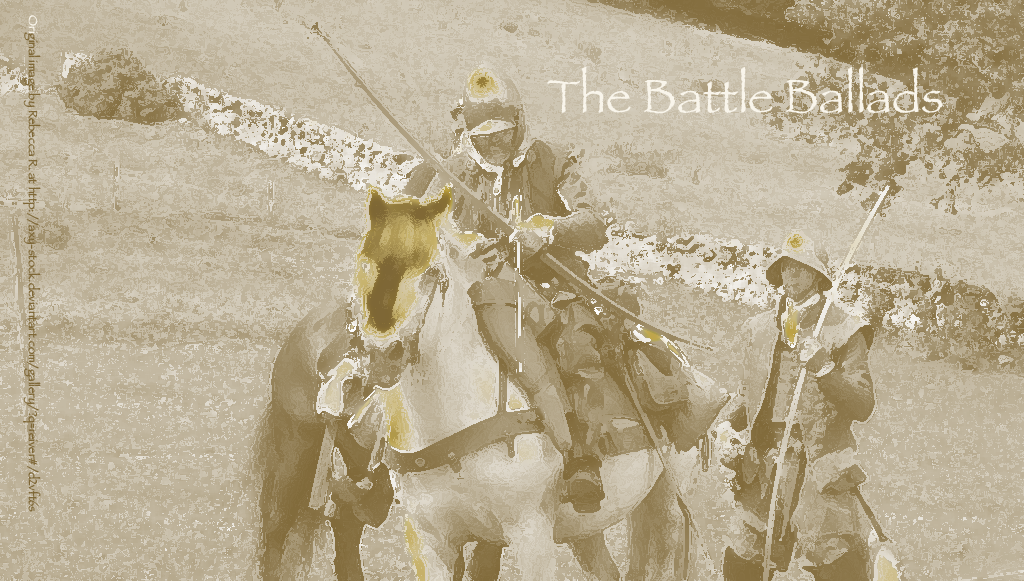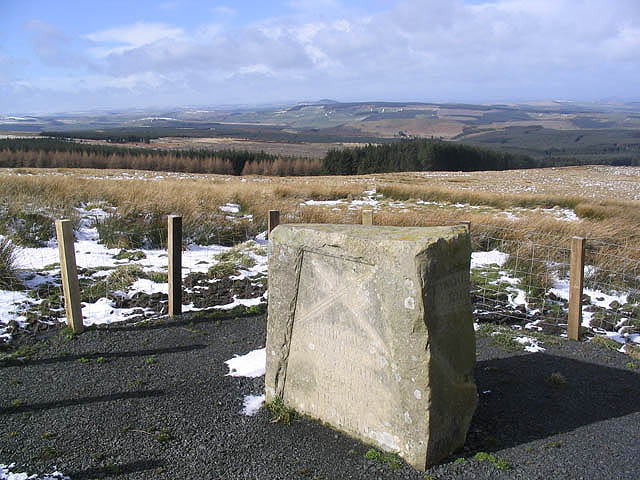The Raid of the Reidswire
“The Raid of the Redeswire” appeared in the first edition of the Minstrelsy of 1802, and appears in all the editions covered by this project. It is the 8th ballad in the 1802 edition. Scott states that he used the copy of the poem from the Bannatyne MS, although he also notes that Allan Ramsay included a version in The Ever Green, entitled “The Ballat of the Reid-Squair fought on the 7th July 1576″.
History
The ballad recounts the notorious actions of the seventh of July 1575, when a run-of-the-mill Warden’s meeting had been arranged between John Carmichael, the Keeper of Liddesdale, and the English Middle March Warden, Sir John Forster. Their respective second in commands were George Douglas and George Heron, Keeper of Redesdale: Heron was subsequently killed in the skirmish.
There would have been fines to be paid, men to be handed over to answer for their crimes, and paperwork to be exchanged. It is unlikely that either side had considered an all-out fight. Things seems to have gone well enough, until the case of one individual was raised. Carmichael demanded that he was handed over, Forster denied knowledge of his whereabouts, which was not believed. Insults were exchanged and then the entire meeting descended into violence. The skirmish seemed to have gone the Scots way due to the the fact that the English mainly fought with bows and swords, but the Scots were armed with firearms as well as more traditional weapons. This skirmish is often cited as the last battle between Scottish and English forces.
Scott identifies the individual whose absence instigated the combat as “Farnstein”: current local tradition, to enter into the spirit of the Minstrelsy notes, attributes the name Henry Robson to the individual in question. However, neither the State Papers of the time nor the letters included in the calendar of Border Papers seem to identify any specific individual.
In terms of Border clashes, there was a low number of fatalities and serious injury. However, the political repercussions of the skirmish lasted over a decade, with Wardens often returning to the wrongs done on the day itself.
The Characters
There are a number of characters in “The Raid of the Reidswire”, which have historical parallels.
THE SCOTS
Carmichael
Sir John Carmichael was the Scottish West March Warden on two occasions (not the Middle March as Scott states), and was also Keeper of Liddesdale. He was considered to be one of the most even-handed and least partizan of the Wardens. He was assassinated by a faction of Armstrongs in 1600.
The Laird’s Wat
This is considered to be Walter Scott of Buccleuch by Scott, but in Walter Scott of Satchell’s account of the Reidswire affray, he claims that this would have been Walter Scott of Ancrum. However, Scott gives the genealogy of the Ancrum Scotts and makes the reasonable assumption that since the line did not exist at the time of the battle, it could not have been a Scott of Ancrum.
Douglases “The Sheriffe” – Douglas of Cavers
By the 16th century, the Douglas family had lost all claims to the Scottish throne and had been decimated at the battle of Arkinholm. However, they still had held posts in the Borders and were a notable family with various cadet branches. The family held the title of Sheriff of Cavers. In 1575, this would be Sir William Douglas.
Beanjeddart – Bonjedward
This most probably refers to the Douglases of Bonjedward.
Cranstane
This refers to John Cranstane of that Ilk . He was a Border nobleman. The Cranstone family married into the Douglas family of Cavers
Gladstain
The Gladstones – also Gledstanes – owned various lands throughout the Borders. One branch had been adherents to the Douglas family for generations, but then changed alliances to serve the Scotts of Branxholme. The family had close links with Roxburghshire and also with Dumfries, with several generations serving as baillies, often under the Wardenship of the Maxwell Lords.
Trumbills – Turnbulls
The Turnbull clan had strongholds around Jedburgh.
Notable families were:
Turnbulls of Hundlie (Hundalee)
Turnbulls of Bedrule
Turnbulls of Edderstane
Rutherfords
The Rutherfords were a notable family of the Scottish Middle March. Their epithet was the “Riding Rutherfords”
Hunthill was one of their strongholds
Laird of Mow (Molle)
The Laird of Mow appears in the Calendar of Border Papers. HOwever, as Scott notes, there seems to be no documentation that he died at the Reidswire.
Kers of Graden
Graden was traditionally a Kerr seat. In 1575, the title would have been that of Andrew Ker(1545-19/12/1599). An Andrew Ker, called ‘the tutor of Graden’ is noted as being a rider in 1590, with his loot being reset by Robin Elliot.
THE ENGLISH
John Forster
Sir John Forster was one of the dominant characters throughout the 1500s. He was Warden of the English Middle March between 1560-86 and 1588-95. Early in his career, he fought at Solway Moss. In 1575, he was captured at the Redeswire. He served as Sherrif of Northumberland 1549-50. He died at Bamburgh 13/1/1602.
Sir George Heron of Chipchasehouse
Sir George Heron was the Keeper of Redesdale before 1573 (noted in Sep 1597 (CBP I 402), and Captain of Harbottle Castle. His death at the Reidswire noted in the CBP. References to the event continue a decade and more later (CBP I, 205-6).(CBP II 602 (Oct 18 1598) and Feb 1599 (CBP II 590). His political biography can be found here.
The Fenwicks
The Fenwicks were an English clan and were listed as gentlemen of the English Middle Marches in Musgrave’s list compiled in July 1583.
Sir Francis Russell
Sir Francis Russell was son-in-law to John Forster. He was killed in another skirmish in 1585, which took place between Sir John Forster and Thomas Ker of Fairniehurst.
William Fenwick of Wallington
William Fenwick of Wallington was born c. 1550, and served as Deputy Warden to Sir Robert Carey. He was Sherrif of Northumberland in 1578 & 1589. He died 15/8/1613. There are references to him being at the Redeswire in a number of 19th-century books, but many take the ballad as their source.
Cuthbert Collingwood
Sir Cuthbert Collingwood was a notable gentleman in the Bewcastle area. He was born c. 1540. He was buried 29th Dec. 1596, and was Sheriff of Northumberland at time of death. He was taken prisoner at Reidswire but released, as the other English gentlemen were, after a short time. He ws also a commissioner for English West and Middle Marches.
_________________________________________________
Redeswire Stone image:
© Copyright Walter Baxter and licensed for reuse under this Creative Commons Licence.

